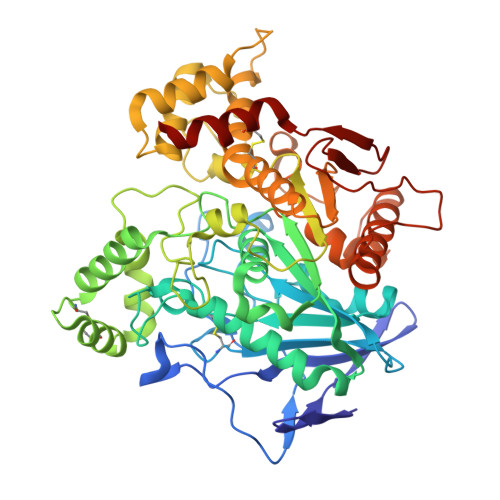Crystal Structures of Human Cholinesterases in Complex with Huprine W and Tacrine: Elements of Specificity for Anti-Alzheimer'S Drugs Targeting Acetyl- and Butyrylcholinesterase.
Nachon, F., Carletti, E., Ronco, C., Trovaslet, M., Nicolet, Y., Jean, L., Renard, P.(2013) Biochem J 453: 393
- PubMed: 23679855
- DOI: https://doi.org/10.1042/BJ20130013
- Primary Citation of Related Structures:
4BDS, 4BDT - PubMed Abstract:
The multifunctional nature of Alzheimer's disease calls for MTDLs (multitarget-directed ligands) to act on different components of the pathology, like the cholinergic dysfunction and amyloid aggregation. Such MTDLs are usually on the basis of cholinesterase inhibitors (e.g. tacrine or huprine) coupled with another active molecule aimed at a different target. To aid in the design of these MTDLs, we report the crystal structures of hAChE (human acetylcholinesterase) in complex with FAS-2 (fasciculin 2) and a hydroxylated derivative of huprine (huprine W), and of hBChE (human butyrylcholinesterase) in complex with tacrine. Huprine W in hAChE and tacrine in hBChE reside in strikingly similar positions highlighting the conservation of key interactions, namely, ¦Ğ-¦Ğ/cation-¦Ğ interactions with Trp86 (Trp82), and hydrogen bonding with the main chain carbonyl of the catalytic histidine residue. Huprine W forms additional interactions with hAChE, which explains its superior affinity: the isoquinoline moiety is associated with a group of aromatic residues (Tyr337, Phe338 and Phe295 not present in hBChE) in addition to Trp86; the hydroxyl group is hydrogen bonded to both the catalytic serine residue and residues in the oxyanion hole; and the chlorine substituent is nested in a hydrophobic pocket interacting strongly with Trp439. There is no pocket in hBChE that is able to accommodate the chlorine substituent.
Organizational Affiliation:
D¨¦partement de Toxicologie, Institut de Recherche Biom¨¦dicale des Arm¨¦es, 24 Avenue des Maquis du Gr¨¦sivaudan, BP87, 38702 La Tronche, France. florian@nachon.net























